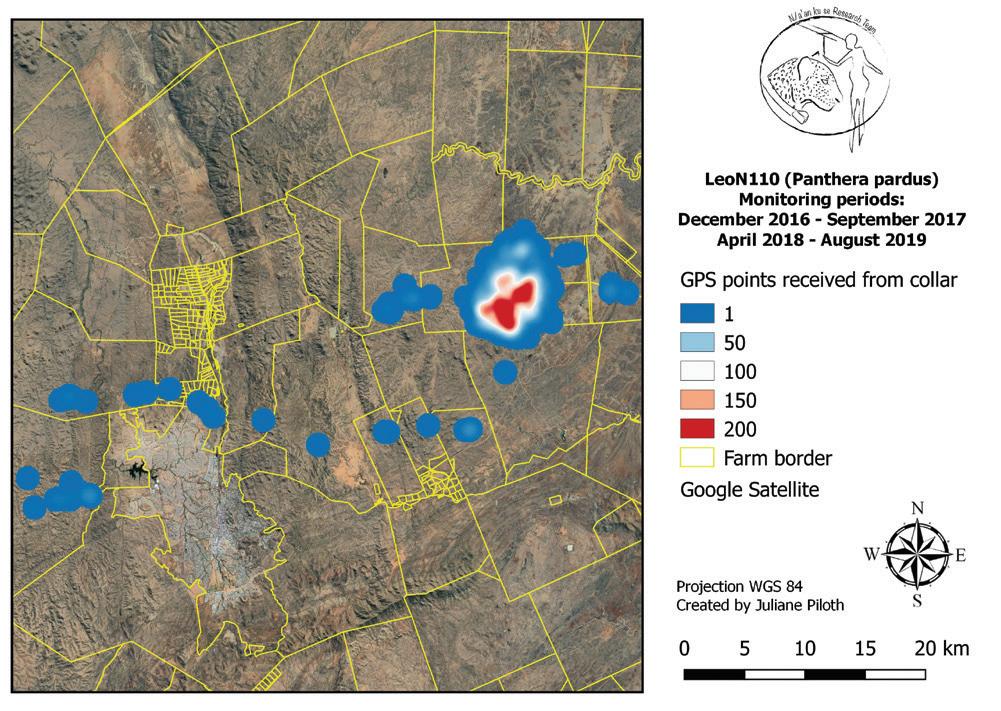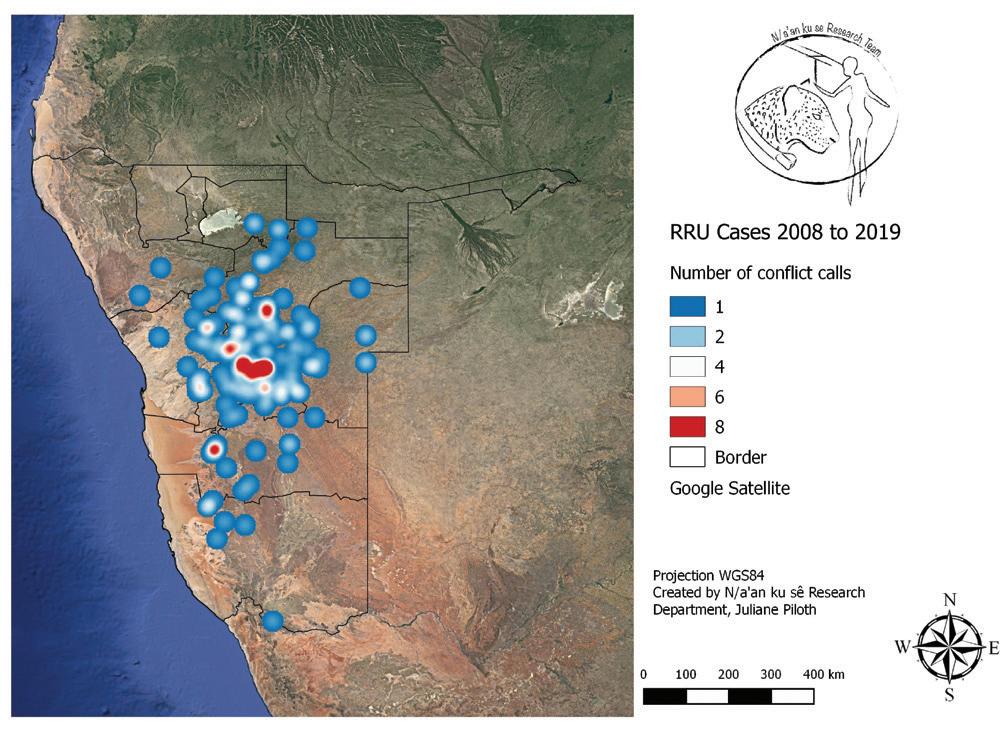
7 minute read
Working with Farmers to conserve Namibian carnivores
By Juliane Piloth, N/a’an ku sê
The N/a’an ku sê Rapid Response Unit (RRU) Project was launched in 2008 with the aim to reduce the conflict between humans and large carnivore species on Namibian farmland. In Namibia, more African wild dogs, cheetahs and leopards occur outside of protected areas than within them. There are around 4,000 freehold farms in Namibia, accounting for more than 40% of the country and thus providing vital habitat and prey for large carnivores. Namibia is one of the few countries in the world where livestock numbers exceed the human population. Consequently, while there is ample space for carnivores to roam without coming into direct contact with people, they will inevitably come into conflict with farmers when they kill livestock or valuable game species.
The RRU is a team of biologists, researchers and wildlife veterinarians. The team responds quickly and reliably to farmers reporting different types of conflict with various carnivore species. The RRU is equipped to deal with situations where carnivores have been caught in traps, or just to provide advice about livestock protection based on the team’s knowledge of carnivore biology.
Our work with local farmers and landowners aims to not only conserve free-roaming carnivore populations in their current ranges, but also to help farmers with practical, cost-effective and non-lethal tools to reduce their losses to carnivores. This strategy promotes tolerance and co-existence, which is critical to reducing human-carnivore conflict in the long term. Through this project we strive to fill the existing gap between species-based conservation research and the vast knowledge obtained by farmers over decades. We do so by working directly with these landowners, who will ultimately determine whether carnivore populations will continue to exist on their properties.
The RRU team’s methods vary according to the type of conflict incident and the results of discussions with each farmer on the way forward in each specific case. The team holds consultations to help resolve carnivore problems and provides monitoring data from satellite collars fitted on carnivores released on farmland as well as technical assistance for implementing innovative livestock management techniques. We are committed to secure the future of wild large carnivores in Namibia outside state-protected areas through applied research, community engagement and adaptive management practices. This involves reducing lethal control methods, securing more safe space where farmers tolerate carnivore presence, collecting crucial data to guide management actions, and ultimately keeping as many large carnivores as possible in their native home ranges.
We have worked with over 820 farmers since 2008. Nearly two-thirds of them experienced livestock, game, or domestic animal losses prior to calling us. Out of that percentage, 31% were reaching out to the RRU to seek advice for reducing their losses, while 68% had captured the suspected predator and wanted the RRU to assist by collaring or translocating it.
Many farmers are open to the idea of fitting a GPS-collar on the captured predator and releasing it back on the farm. This is an ideal outcome because it gives us the chance to monitor its movement and establish if it is in fact a problem animal or not. We then relay this information to the farmer on a daily basis to maintain clear lines of communication and maximum transparency about what the predator is doing on the property. This system provides the farmer with a chance to develop effective livestock protection strategies based on a better understanding of how predators use their land. From a total of 202 carnivores captured, the farmers allowed us to release 58 on their land with a collar and 27 without a collar, while 102 were translocated to suitable release sites elsewhere.
We keep records of every incident we respond to, which allows us to look at interesting trends in human-carnivore conflict over time. When the RRU first began its work in 2008, most incoming conflict calls were about cheetahs. From 2014 onwards, conflict calls relating to leopards spiked and now greatly exceed the number of calls for any other species. In 119 of the 183 leopard conflict calls, farmers had captured the leopard and reached out to the RRU for assistance.
The downward trend in cheetah-related conflict is worrisome, since the cheetah population across southern Africa is continuously declining. A decrease in conflict calls is of grave concern, as it could mean that there are fewer cheetahs on Namibian farmlands. A working theory of why leopard conflict calls have been on the rise relative to other carnivore conflict, relates to the method applied by farmers to catch carnivores on their property. Capture cages fitted with bait will attract large carnivores such as leopard and hyaena, but not cheetah, since these cats will only feed on fresh kills and in addition they do not rely on the sense of smell
Heatmap showing Otuini’s movement over two study periods. To the left of the map is the Park she was translocated to; the core area (indicated in red, where she spends most of her time) is the farm she was initially caught on.
Heatmap showing conflict cases reported to N/a’an ku sê between 21 st of May 2008 and 31 st of December 2019. Core areas (indicated in red) are those areas we get the most conflict calls from.

Nina van Zyl
for hunting. That makes bait impractical for capturing cheetah. Furthermore, a subjective observation is that landowners tend to shoot cheetah on sight, whereas other large carnivores are more likely to be caught and reported.
One of the key lessons we have learned since the RRU began is that not every carnivore actually causes livestock losses. We therefore recommend to the farmer that we gather more evidence before deciding to remove the animal from its natural habitat. Especially in the case of territorial animals like leopards there is a risk that if an ‘innocent’ animal is removed from its territory, it could be replaced by another leopard which does in fact prey on livestock. In other cases, if an animal is not translocated far enough from the farm of origin, it could simply return to the farm where it was captured – nothing is really achieved. It is therefore in the farmer’s own interest to find out if the animal that was caught is actually killing livestock before deciding what to do about it.
One case that illustrated this was the capture, collaring and release of a female leopard in the Khomas Region towards the end of December 2016. The leopard in the cage trap was pregnant and the farmer suspected her of killing cattle calves. He nonetheless agreed to allow the RRU team to collar and release
The RRU team is happy to assist anyone in Namibia with any problems or queries regarding human-carnivore conflict. For more information, or to get in touch with the RRU team, please contact us via email at research@naankuse.com or call our RRU phone at +264817561636.


Nina van Zyl
her (we nick-named her Otuini) on his farm that same day. The initial monitoring period lasted nine months until September 2017, but this ended prematurely when the GPS-collar malfunctioned. Otuini was caught once more in a cage trap on the same property in April 2018 which allowed us to re-collar her and commence with a second monitoring period that lasted until August 2019. Before releasing her the second time, the farmer had requested for her to be translocated off his property, thus she was taken to a National Park about 50 km away, as stipulated by the Ministry of Environment, Forestry and Tourism’s permit requirements. Interestingly, it took her only 14 days to walk back to the farm where she was first caught. This supports the findings of former N/a’an ku sê researcher, Dr. Florian Weise, who concluded that a translocation threshold distance of at least 200 km was needed to stop large carnivores from returning to their capture locations.
These studies also revealed, however, that this particular leopard is not a problem animal – she did not kill a single livestock animal during the 25 months that we tracked her movements. Otuini occupies a territory of over 8,000 hectares that covers multiple farms. Because she does not kill livestock and will naturally prevent other females from occupying her territory, Otuini may actually be limiting the livestock losses experienced on these farms. Due to our close working relationship and informationsharing with the farmers in the area Otuini was allowed to stay in her territory and has successfully raised a cub.
Otuini’s success story inspires us to continue working with farmers and providing the information they need to inform their carnivore management decisions. We are especially encouraged when farmers allow us to release leopards back onto their properties in order to learn more about them. Developing strong working relationships with farmers based on transparent informationsharing and mutual understanding is key to reducing humancarnivore conflict and thus securing the future of these animals on farmlands throughout Namibia.










